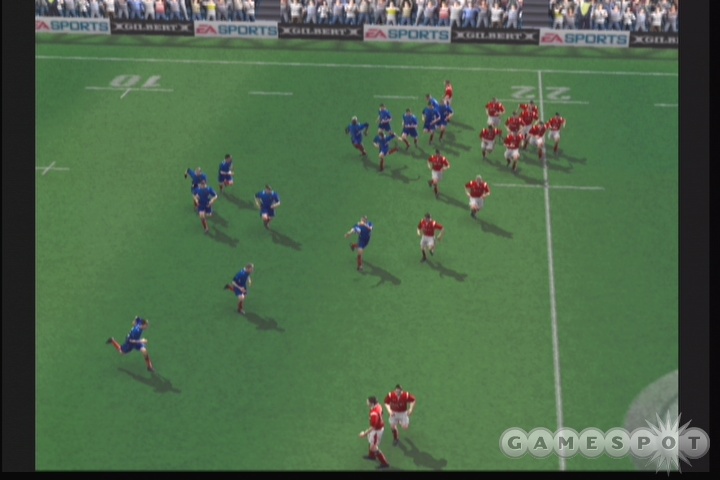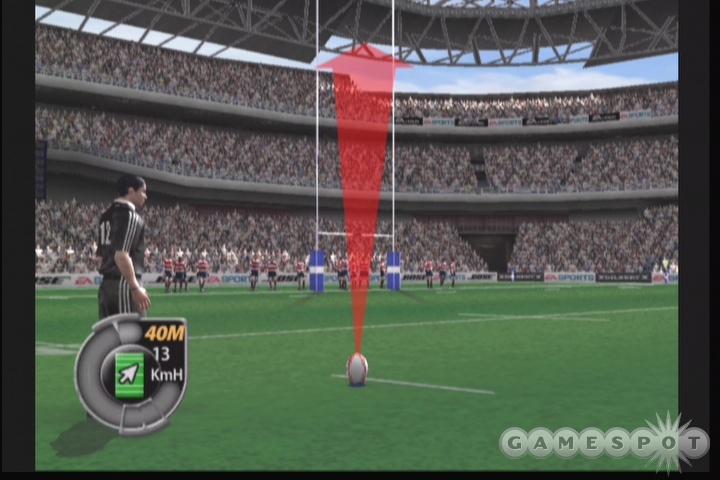Rugby 2005 Hands-On
We take off the helmets and pads to enter the scrum with Rugby 2005.
When most Americans think of rugby, they think of thick-necked lugs sporting J. Crew casual wear while ramming one another's heads into the ground with alarming fury. While the sport hasn't really caught on beyond college campuses here in the States, there's no denying its worldwide popularity, especially among the Pacific Rim territories, including Australia, New Zealand, Fiji, and the like. Apparently, the folks at EA Sports believe there must be a market for rugby games here, because this is the second installment in a row the publisher has released on the Playstation 2 and Xbox. We recently hopped into the scrum with Rugby 2005 to see how the game is progressing in advance of its early March release.

The best phrase we've heard used to describe rugby is "Option football on crack." Indeed, the main component of rugby does resemble Nebraska Cornhusker football circa 1995, with tons of sideline-to-sideline running and lateral passing. In fact, forward passing is illegal in the sport. Instead, you advance the ball by running and tossing the ball behind you, progressing downfield via a quickly moving wedge of backs. Inevitably you'll be tackled by one of the 15 members of the opposing team. Assuming your team can maintain possession of the ball in the ruck (a sort of mini-scrum that takes place after the ball is downed), you continue down the field in the same wedgelike manner as before.
In Rugby 2005, running is controlled with the left analog stick, while passing is controlled either by face buttons (on the Xbox controller) or triggers (on the PS2 controller). Sprinting is accomplished with a shoulder button, and while the game's tutorial claims that players can tire if they run too hard, we didn't see fatigue set in with any of our players during our time with this work in progress. There are also a number of special moves you can execute when in possession of the ball, including sidesteps and charges, by moving the right analog stick in relation to the direction your player is heading. To sidestep, move the right stick 90 degrees away from the direction of the left thumbstick. To charge, move the two sticks parallel. It's a bit confusing at first, but, truthfully, at the default difficulty levels, we didn't see much need for these types of special moves.
The other obvious method for advancing the ball up the pitch is kicking, whether through soccer-style short kicks or by punting the ball long distances when trapped deep in your own territory. While you control the power of a kick through a face button on your controller, you can also aim your kicks with the left control stick to ensure your kickoffs, punts, and drop goal kicks land where you want them to. The only exception is the conversion kick, essentially a two-point extra point attempt controlled by using a kick meter that should be familiar to anyone who's ever played an NFL video game.
Scrums and rucks are fairly automatic affairs, though you must manually "feed" a ruck by adding individual players to the pile. In a scrum, you'll drop the ball into the pile and perform a hook to gain possession, all while pushing the analog stick in the direction you wish to drive the scrum. If you keep possession of the ball, you simply then toss it to your backs and continue your way down the field, looking to either score a "try" (essentially a five-point touchdown) or make a successful drop kick through the narrow uprights to earn a three-point drop goal kick.
The defensive controls are quite simple. Movement and sprinting are executed as normal, and dive tackles are tied to a face button on your controller. Perhaps the trickiest part of defense, especially for those new to the game, is making sure you don't cross over the offsides line during a ruck, which is something we did too many times to count during our first hour or two with the game.

Rugby 2005 features leagues and teams from all over the international rugby map, including associations such as the Super 12, Representative, European, and International. Well-known teams such as the All Blacks from New Zealand and the Australia (Qantas) Wallabies are on hand, as are European league teams such as Bath, Gloucester, Leicester, and the London Wasps. Additionally, you'll find that teams from disparate locations like South Africa, Fiji, Canada, and Italy are all playable. And in case you're wondering, there is a US team as well, though it's one of the lowest-rated teams in the game. If you're looking for some early success, you'd be better served by choosing another squad as your favorite team.
Graphically, the game won't turn any heads, if only because the camera is drawn back quite far to take in as much of the field as possible. The default side-view camera can make drop goal kicks practically impossible, but switching the camera view to "classic" (an up-and-down view of the field) cures that problem immediately. Ian Robertson's play-by-play commentary is well executed and understated, which is something that can't be said for the musical soundtrack, a typical roster of in-your-face rock cuts courtesy of EA Trax.
The game's create-a-player mode lets you edit a number of preset faces, but it doesn't approach the level of depth found in other EA Sports titles, such as Tiger Woods PGA Tour 2005 or Fight Night Round 2. You'll typically take your created player into the game's World League tournament mode, the Rugby 2005 equivalent of a franchise feature, where you'll guide your team up (or down) the divisional ladder towards the top division championship. Other tournament types include the Super 12, European Trophy, and Lions Tour, as well as the Ten, Six, and Tri-Nations tourneys...and, of course, there's the World Championship. Rugby 2005's other main gameplay modes include a quick game mode and practice mode (which includes several interactive training exercises).
So far, we've had more fun learning about the ins and outs of rugby as a sport than we've had fun with Rugby 2005 as a game. We'll see if the final product, set for release in March, avails itself as something more than an interesting introduction to a game many American sports fans are completely oblivious to.
Editor's note 02/16/2005: Our original preview of this game contained an incorrect statement about the game's franchise mode. We have since corrected this mistake. GameSpot regrets the error.
Got a news tip or want to contact us directly? Email news@gamespot.com
Join the conversation